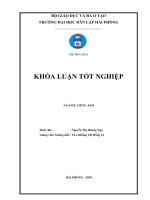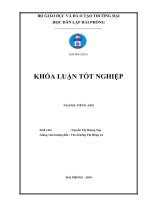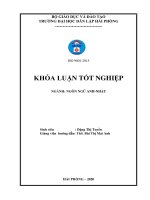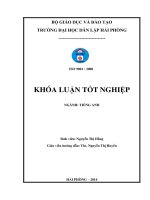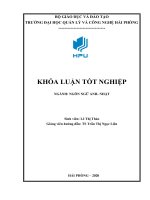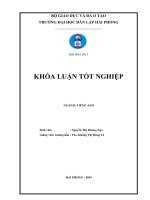A study on the difficulties faced by the first year english majors at haiphong management and technology university and stratergies to help for their self improvement in listening skill
Bạn đang xem bản rút gọn của tài liệu. Xem và tải ngay bản đầy đủ của tài liệu tại đây (1.43 MB, 56 trang )
BỘ GIÁO DỤC VÀ ĐÀO TẠO
TRƯỜNG ĐẠI HỌC QUẢN LÝ VÀ CƠNG NGHỆ HẢI PHỊNG
-------------------------------
ISO 9001:2015
KHĨA LUẬN TỐT NGHIỆP
NGÀNH : NGÔN NGỮ ANH
Sinh viên
: Nguyễn Thị Thùy Linh
Giảng viên hướng dẫn: Ths.Nguyễn Thị Thu Huyền
HẢI PHÒNG 07– 2020
1
BỘ GIÁO DỤC VÀ ĐÀO TẠO
TRƯỜNG ĐẠI HỌC QUẢN LÝ VÀ CƠNG NGHỆ HẢI PHỊNG
-----------------------------------
A STUDY ON THE DIFFICULTIES FACED BY THE
FIRST-YEAR ENGLISH MAJORS AT HAIPHONG
MANAGEMENT AND TECHNOLOGY UNIVERSITY
AND STRATERGIES TO HELP FOR THEIR SELFIMPROVEMENT IN LISTENING SKILL
KHÓA LUẬN TỐT NGHIỆP ĐẠI HỌC HỆ CHÍNH QUY
NGÀNH: NGƠN NGỮ ANH
Sinh viên
: Nguyễn Thị Thùy Linh
Giảng viên hướng dẫn: Ths.Nguyễn Thị Thu Huyền
HẢI PHÒNG 07 – 2020
1
BỘ GIÁO DỤC VÀ ĐÀO TẠO
TRƯỜNG ĐẠI HỌC QUẢN LÝ VÀ CƠNG NGHỆ HẢI PHỊNG
--------------------------------------
NHIỆM VỤ ĐỀ TÀI TỐT NGHIỆP
Sinh viên: Nguyễn Thị Thùy Linh
Lớp
: NA1901A
Ngành
: Ngôn Ngữ Anh
Mã SV: 1512751004
Tên đề tài: A study on the difficulties faced by the first-year English majors at
HaiPhong Management and Technology University and stratergies to help for their
self-improvement in listening skill
1
NHIỆM VỤ ĐỀ TÀI
1. Nội dung và các yêu cầu cần giải quyết trong nhiệm vụ đề tài tốt nghiệp
………………………………………………………………………………….
………………………………………………………………………………….
………………………………………………………………………………….
………………………………………………………………………………….
………………………………………………………………………………….
………………………………………………………………………………….
2. Các tài liệu, số liệu cần thiết
………………………………………………………………………………….
………………………………………………………………………………….
………………………………………………………………………………….
………………………………………………………………………………….
………………………………………………………………………………….
3. Địa điểm thực tập tốt nghiệp
………………………………………………………………………………….
1
CÁN BỘ HƯỚNG DẪN ĐỀ TÀI TỐT NGHIỆP
Họ và tên
: Nguyễn Thị Thu Huyền
Học hàm, học vị
: Thạc sĩ
Cơ quan công tác
: Trường Đại học Quản lý và Công nghệ Hải Phòng
Nội dung hướng dẫn: A study on the difficulties faced by the first-year English majors at
HaiPhong Management and Technology University and stratergies to help for their selfimprovement in listening skill
Đề tài tốt nghiệp được giao ngày 03 tháng 08 năm 2020
Yêu cầu phải hoàn thành xong trước ngày 16 tháng 10 năm 2020
Đã nhận nhiệm vụ ĐTTN
Sinh viên
Đã giao nhiệm vụ ĐTTN
Giảng viên hướng dẫn
Hải Phòng, ngày 01 tháng 07 năm 2020
HIỆU TRƯỞNG
TS. Nguyễn Tiến Thanh
1
CỘNG HÒA XÃ HỘI CHỦ NGHĨA VIỆT NAM
Độc lập - Tự do - Hạnh phúc
PHIẾU NHẬN XÉT CỦA GIẢNG VIÊN HƯỚNG DẪN TỐT NGHIỆP
Họ và tên giảng viên:
...................................................................................................
Đơn vị công tác:
........................................................................ ..........................
Họ và tên sinh viên:
.......................................... Chuyên ngành: ...............................
Nội dung hướng dẫn:
.......................................................... ........................................
....................................................................................................................................
1. Tinh thần thái độ của sinh viên trong quá trình làm đề tài tốt nghiệp
..............................................................................................................................................
....... ..............................................................................................................................................
....... ..............................................................................................................................................
....... ..............................................................................................................................................
....... ..............................................................................................................................................
....... ..............................................................................................................................................
2. Đánh giá chất lượng của đồ án/khóa luận (so với nội dung yêu cầu đã đề ra trong nhiệm vụ
Đ.T. T.N trên các mặt lý luận, thực tiễn, tính tốn số liệu…)
....... ..............................................................................................................................................
....... ..............................................................................................................................................
....... ..............................................................................................................................................
....... ..............................................................................................................................................
....... ..............................................................................................................................................
....... ..............................................................................................................................................
....... ..............................................................................................................................................
3. Ý kiến của giảng viên hướng dẫn tốt nghiệp
Được bảo vệ
Khơng được bảo vệ
Điểm hướng dẫn
Hải Phịng, ngày … tháng … năm ......
Giảng viên hướng dẫn
(Ký và ghi rõ họ tên)
QC20-B18
1
CỘNG HÒA XÃ HỘI CHỦ NGHĨA VIỆT NAM
Độc lập - Tự do - Hạnh phúc
PHIẾU NHẬN XÉT CỦA GIẢNG VIÊN CHẤM PHẢN BIỆN
Họ và tên giảng viên:
..............................................................................................
Đơn vị công tác:
........................................................................ .....................
Họ và tên sinh viên:
...................................... Chuyên ngành: ..............................
Đề tài tốt nghiệp:
......................................................................... ....................
....................................................................................................................................
....................................................................................................................................
1. Phần nhận xét của giáo viên chấm phản biện
....... ..........................................................................................................................................
....... ..........................................................................................................................................
....... ..........................................................................................................................................
....... ..........................................................................................................................................
....... ..........................................................................................................................................
....... ..........................................................................................................................................
....... ..........................................................................................................................................
2. Những mặt còn hạn chế
..........................................................................................................................................
....... ..........................................................................................................................................
....... ..........................................................................................................................................
....... ..........................................................................................................................................
....... ..........................................................................................................................................
....... ..........................................................................................................................................
....... ..........................................................................................................................................
3. Ý kiến của giảng viênchấm phản biện
Được bảo vệ
QC20-B19
Không được bảo vệ
Điểm phản biện
Hải Phòng, ngày … tháng … năm ......
Giảng viênchấm phản biện
(Ký và ghi rõ họ tên)
1
TABLE OF CONTENTS
ACKNOWLEDGEMENTS
PART I: INTRODUCTION
1. Rationale of the study
2. The aims of the study
3. Research questions
4. The method of the study
4.1 Research methodology
4.2 Survey questionnaires
4.3 Population and sample
5. The organization of the study
PART II: DEVELOPMENT
CHAPTER 1: THEORETICAL BASIS OF THE STUDY
1. Definition of listening
2. Definition of listening comprehension
3. Significance of listening
4. Types of listening
4.1 Casual listening
4.2 Focused listening
5. Factors make listening difficult.
5.1 Factors relating to listener
5.1.1 Lacking necessary listening skills
5.1.2 Attitude factor
5.1.3 Hearing habits are impaired
5.1.4 Students have problems with different accents
5.2 Factors relating to listening materials and some another factor
5.2.1 Incorrect and insufficient codes
5.2.2 Psychological quality and external environmental barriers
5.2.3 Inappropriate listening material
1
5.2.4 The class atmosphere
CHAPTER 2: DATA ANALYSIS DISCUSSION AND RESULT
1. The Analysis of the Data Collected from Questionnaire
1.1 Students’ attitude toward learning English in general and listening skill in
particular
1.2 Listening Problems Related to the Content of The Listening Text
1.2.1 Problems pertinent to unfamiliar word
1.2.2 Problem pertinent to various grammartical structures
1.2.3 Problem pertinent length of spoken text
1.2.4 Problem pertinent fatigue of long spoken text
1.2.5 Problem pertinent to unfamiliar topic
1.2.6 Problem pertinent to the unclear pronunciation
1.2.7 Problems pertinent to unknown words
1.2.8 Problems pertinent to recognize the word
1.2.9 Problems pertinent to variety of accents
1.3 Listening Problems Related to the Listener’s competence
1.3.1 Problem pertinent to understand every single word in the text
1.3.2 Problem pertinent to inability of understanding listening tasks
1.3.3 Problem pertinent lack basic background knowledge
1.3.4 Problem pertinent to anxiety while listening
1.3.5 Problem pertinent to lose focus when get an expected answer
1.3.6 Problem pertinent unable to concentrate when answer and listen at the same time
1.3.7 Problem pertinent to memory
1.3.8 Problem pertinent inability to get repeated
1.4 Listening Problem Related to Physical Setting
1.4.1 Problem pertinent lose concentration because poor quality of recording
1.4.2 Problem pertinent noise around
2. The result of interview
2.1 Problems Affect Listening Comprehension of Learner
1
2.2 Problems toward Listening Material
2.3 Problems to Answer the Question during Listening
2.4 Problems Lose Concentration during Listening
2.5 Problems Using Personal Experience
CHAPTER 3: SUGGESTION FOR SELF IMPROVEMENT
1. Active listening
2. Learn Actively by Taking Notes
3. Read and listen at the same time
4. Practice daily for short memory
5. Try Watching Movies or Listening to Podcasts After English class
6. Improve listening skill by listening English song
7. Vary Your Listening Routine
8. Ask your classmates for help
9. Listen to What You Enjoy
PART III: CONCLUSION
1. Summary of the study
2. Limitation of the study
3. Suggestions for the further study
REFERENCES
APPENDIXES
APPENDIX A
APPENDIX B
1
ACKNOWLEDGEMENTS
In the process of doing my research paper, I have received a lot of experience,
guidance and encouragement from my teachers and friends. To begin with, I would
like to express my deepest gratitude to my supervisor Ms. Nguyen Thi Thu Huyen, the
lecturer of foreign language faculty, Haiphong Management and Technology
University, for her whole-hearted guidance and support. Without her valuable
recommendations and advice, I could not finish this thesis successfully.
My special thanks are also extended to all instructors at the Language Institute,
Haiphong Management and Technology University who have educated and provided
me the knowledge and experience throughout the years of my study in this program.
Lastly, special thanks and love to my family who always beside and gave their
encouragement and support in my education and every other aspect of life.
1
PART I: INTRODUCTION
1. Rationale of the study:
Listening is receiving language through the ears. Listening involves identifying
the sounds of speech and processing them into words and sentences. When we listen,
we use our ears to receive individual sounds (letters, stress, rhythm and pauses) and
we use our brain to convert these into messages that mean something to us. Listening
in any language requires focus and attention. It is a skill that some people need to
work at harder than others. People who have difficulty concentrating are typically
poor listeners. Listening in a second language requires even greater focus.
As a researcher, I would like to present “The difficulties faced by the first-year
English majors at Haiphong Management and Technology University and stratergies
to help for their self- improvement in listening skill” for several reasons.
First of all, listening is a vital skill for language learning. Research shows that
when we communicate, we spend around 40-50% of our time listening, 25-30%
speaking, 11-16% reading and only 9% writing (although that last one might have
changed in recent years due to the rise in social media). Moreover, in learning a
language, listening is a useful means of providing students with comprehensible input,
which is an essential component of the whole language learning proces. Therefore, I
would like to do this research to help students pay more attention to listening skill.
Secondly, learning listening skill is the most difficult in learning a foreign
language. Listening, like reading, is a receptive skill but it is often the most daunting
for students. When reading, a reader usually has more opportunities to refer back to
the text to clarify understanding, which a listener can not do in most listening contexts
such as TV programs, meetings, discussion, lectures or conversations. That is the
reason I would like to out some suggestion so as to help teachers motivate their
students to study listening skill more excited and better.
After studying at the Faculty of Foreign Languages, Haiphong Management and
Technology University, for nearly four years, I realize that the first-year students of
English major still have many difficulties in their listening skill. In the hope of finding
out the solutions learning listening , a study : “The difficulties faced by the first-year
English majors at Haiphong Management and Technology University and stratergies
to help for their self- improvement in listening skill” has been conducted because of
all above mentioned reason.
4
2. The aims of the study
The study is done with the following aims:
- Firstly, the study is carried out in order to survey the real state of learning
English listening skill in Haiphong Management and Technology University so
that I can work out the solutions.
- Secondly, most students find it difficult to learn listening skill so I would like to
find out the common difficulties encountered by the 1st year English majors
when they study English listening skill at Haiphong Management and
Technology University.
- Finally, due to such difficulties, many students are not interested in learning and
practicing this skill in class, therefore the study would like to suggest some
possible solutions to help for their self- improvement in listening skill. These
solutions also aim to help the students catch up with the speed of a normal
conversation in the real life so that they can improve their communication
competence.
3. Research questions
1. What are the real situations of learning English listening skill for the first- year
students in Faculty of Foreign Languages at Haiphong Management and
Technology University ?
2. What are the difficulties of listening to English at Haiphong Management and
Technology University ?
3. What are solutions to help for their self- improvement in listening skill for the
first-year students in Faculty of Foreign Languages at Haiphong Management
and Technology University ?
4. The method of the study:
4
4.1
Research methodology
The researcher used Quantitative and Qualitative method for the study. The
quantitative method is questionnaire-based survey of 20 the first year English-major
students at HaiPhong Management and Technology University. The qualitative
method is observations and a semi-structured interview for students used to enrich the
quantitative data. Interview process was held to know deeply about the students’
difficulties. Then, all of the result questionnaire and interview were analyzed.
4.2 Survey questionnaires
In terms of the methods, the questionnaire is designed as a mean for researcher
to collect data. Questionnaires are more convenient, take less time, cheap and easy for
students to answer. Moreover, questionnaires are considered more reliable way since
they are anonymous and this encourages greater honesty. Questionnaires included
closed and open-ended questions. The questionnaire is given to students of the firstyear students of foreign languages department with the hope to find out their attitudes
towards their listening skill and their difficulties in listening to English as well as their
expectations to their teachers. As they are in their first academic year, they often
experience such problems. It is stage that students should be equipped with variety of
techniques right from their early listening. With appropriate strategies, they will have
built up their listening skill by the time.
After gathering all the results of questionnaire with answers, the method of
analyzing data is applied. Basing on the statistic numbers, I analyze and find out the
situation, difficulties and then causes in order to suggest reasonable and effective
solutions for the problem.
4.3 Population and sample
With the aim of completing the research, the researcher will need a group of
participants called the population of the study. In this study, freshmen of Foreign
Languages Department at Haiphong Management and Technology University will be
the population. The total is 20 students in academic year 2019 – 2020. The research
took all 20 students at class NA2301 as the sample of the research.
4
A large numbers of them have learnt English for 7 years (4 years at secondary
school and 3 years at high school). However, their English backgrounds are quite
similar because of the influence of curriculum of English for high schools students in
the past, students did not have many chances to practice English skills. Thus, when
entering Haiphong Management and Technology University, their English levels were
limited and they have to face up with many difficulties in studying. They have
recognized their difficulties, needs, achievement related to listening activities.
5. The organization of the study
The study includes 3 Parts mainly organize as follows:
Part I: Introduction
Part II: Development
Chapter 1: Theoretical basis of the study
Definition of listening comprehension
The significance of listening
The types of listening
Factors make listening comprehension difficult
Chapter 2: Data analysis and discussion an investigation into the first-year students of
foreign languages department difficulties in listening comprehension
Chapter 3: Recommendations to stratergies to help for their self-improvement in
listening skill
Part III: Conclusion
4
PART II: DEVELOPMENT
CHAPTER 1: THEORETICAL BASIS OF THE STUDY
This chapter is named Theoretical basis of the study in which the researcher will
provide the foundation of knowledge about listening skill so that the readers have an
overview of the topic of the study.It includes the definition, the significance and types
of listening, factors make listening difficult.
1. Definition of listening
Listening has been defined by many researchers. Howatt and Dakin (1974)
defined listening as the ability to identify and understand what others are saying. This
process involves understanding a speaker's accent or pronunciation, the speaker’s
grammar and vocabulary, and comprehension of meaning. An able listener is capable
of doing these four things simultaneously. Moreover, Chastain (1971) said that
listening is the ability to understand native speech at normal speed. According to
Postovsky (1975), listening differs in meaning from sound discrimination to aural
comprehension. Goss (1982) defined listening as a process of understanding what is
heard and organizing it into lexical elements to which meaning can be allocated.
Besides, Bowen et al. (1985) demonstrated that listening is understanding the oral
language. Students hear oral speech, divide sounds, classify them into lexical and
syntactic units, and comprehend the message. Listening is a process of receiving what
the speaker says, making and showing meaning, negotiating meaning with the speaker
and answering, and creating meaning by participation, creativity, and empathy. In
short, listening has been recast as an activity central to the second language (L2)
acquisition process (Krashen, 1985; Dunkel, 1993; Rost, 2002), and a skill integral to
overall communicative competence (Savignon, 1991; Brown, 1994). According to
Krashen (1994), listening is now treated as a much more complex activity and one that
is the cornerstone of language acquisition.
In conclusion, listening is a process of identifying and understanding what the
speakers say, which includes understanding a speaker’s pronunciation, grammar and
vocabulary. Listeners have to know how to conduct and do the process under the
circumstance in an active way, not make listening viewed as a passive process.
2. Definition of listening comprehension
4
Listening comprehension is regarded as a complex, interactive process in which
listeners are involved in a dynamic construction of meaning. Listeners understand the
oral input from sound discrimination, prior knowledge of vocabulary, grammatical
structures, stress and intonation, as well as other use linguistic, paralinguistic, or even
non-linguistic clues in contextual utterance (Rost, 2002).
The increased importance of listening comprehension in language learning may
be attributed largely to the development of communicative language teaching
approach, which attempts to prepare learners to transfer their classroom skills to reallife context, over the past three decades (Asher, 1977; Krashen, 1982; Omaggio
Hadley, 2001; Vande Berg, 1993). There has been a shift from nonteaching listening
comprehension in the audio-lingual period to teaching listening comprehension in a
strategy-based approach (Mendelsohn, 1998). Before World War II, the teaching of
reading was given the most attention while that of listening comprehension was the
most infertile and the least understood language skill (Winitz, 1981). Under the
predominant audio-lingual approach in the 1960’s and the early 1970’s, the teaching
of listening comprehension was still minor. With the increasing interest towards
communicative language teaching approach, several researches revealed the
importance of listening comprehension (Brown & Yule, 1983; Faerch & Kasper,
1986; Feyten, 1991; Long, 1985). Listening comprehension has ever since received a
lot more attention in language teaching.
On the one hand, technological advances and the growing awareness of the
importance of listening in the world have made listening even more important in the
communication process (Mendelsohn, 1998). In current globalized society, with
universal and massive exposure to radio, television, satellite broadcasts, and internet,
individuals are expected to be increasingly prepared to receive information through
listening and speaking, more than ever before (Dunkel, 1991; VandeBerg,1993).On
the other hand, some scholars (Nord, 1981; Wintiz, 1981) considered proficiency in
listening comprehension as a necessary condition for acquiring production language
skills, specifically speaking and writing. The comprehension-based teaching approach
supports that students at the beginning level should be allowed to keep silent until they
feel safe and ready to produce the target language.Thus, it can be reasonably
concluded that students are probably engaged in listening before they are able to speak
and write in the target language, which means that second language instruction at a
beginning level should focus on developing learners’ listening comprehension ability.
Still, other scholars (Dunkel, 1991; Long, 1985; Rost, 1990; Vogely, 1999) stressed
4
that listening is important because it provides input as the raw material for learners to
process in language learning. Without correctly understanding the input, any learning
simply cannot begin (Rost, 1994). Furthermore, the failure of listening comprehension
of the target language is an impetus, not merely an obstacle, to language learning as
well as to communication interaction (Rost, 1994).
The recognition of the importance of listening comprehension has resulted in an
increased number of listening activities in students’ textbooks and even in
comprehension-based methodology texts designed specifically for teaching listening
(Anderson & Lynch, 1988; Rost, 1990; Underwood, 1989; Ur, 1984). Several studies
have found that through the use of effective pre-listening activities, instructors can
increase students’ understanding of the listening passages, which in turn develops their
listening proficiency and contributes to their mastery of the target language (Herron,
1994; Richards, 1983; Rubin, 1994; Teichert, 1996; Vande Berg, 1993).
3. Significance of listening
Listening has an important place in learning as it is one of the four major skills
in language acquisition. Even though the other skills such as reading, speaking and
writing are essential to develop language proficiency, listening contributes primarily
for language expertise. Listening awakens awareness of the language as it is a
receptive skill that first develops in a human being. Learning to listen to the target
language improves language ability. The sound, rhythm, intonation, and stress of the
language can only be perfectly adapted through listening. To understand the nuances
in a particular language, one must be able to listen. As we get to understand spoken
language by listening it is easier to improve the other skills and gain confidence. Other
than being the primary form of communication, listening helps the language learner to
understand the beauty of the language. Especially in terms of communicative language
teaching it is said that the basis for communicative competence is listening as it
provides the aural input and enables learners to interact in spoken communication and
hence language learning largely depends on listening. Thus listening forms the
concrete basis for the complete language proficiency.
4. Types of listening
Listening skills including of two main types are casual and focused listening
going together, up to the aim of listening (Nguyen Thi Van Lam and Ngo Dinh
Phuong, 2006).
4
4.1Casual listening
Casual listening – The term says it all, Listening without showing much
attention. However actual attention may vary a lot from person to person. Its
importance lies in the fact that even though we are not listening carefully, our subconscious is alert to it. Everything that we hear is being observed by the brain and
indirectly it enhances our memory to the point that we can recall certain types of
accent which were being spoken and even more.
4.2Focused listening
Focused listening is intentional and systematic process. The listener gives his
full attention and concentration on what the speaker is saying to get information,
knowledge and ideas. This type of listening is also considered as “ Intensive
Listening".
5. Factors make listening difficult.
It seems that, for a long time, the skill of listening didn’t receive adequate
acknowledgement as a skill in its own right, but rather was long “regarded as a passive
skill, [...] an ability that would develop without assistance” (Osada 2004:53). Such
lack of regard for developing listening skills may seem quite absurd when according
to Burley-Allen (in Flowerdew and Miller 2005:22-23) more than forty percent of our
daily communication time is spent on listening, with thirty-five percent being
dedicated to speaking, sixteen percent devoted to reading and only nine percent of our
daily communication being occupied by writing. It was only really at the turn of the
1970s that listening comprehension began to be explored (Osada 2004:53), conducing
to a shift in listening skills being viewed as a passive skill to being viewed as elements
which students should actively acquire. However, with this newly found accreditation
having only been proportioned very late on in comparison to the other three
standardised language skills (reading, writing and speaking), listening skills have been
rendered the “least researched of all four language skills” (Vandergrift 2007:291).
This lack of research means that listening “remains one of the least understood
processes” (Osada 2004:53), making the effective teaching of these skills a somewhat
grey area, subjecting it to often being viewed as a “somewhat neglected and poorly
taught aspect of English” (Osada 2004:57). Furthermore, the very complex nature of
4
the activity of listening also contributes to the teaching of such skills being a rather
challenging affair indeed.
5.1 Factors relating to listener
5.1.1 Lacking necessary listening skills
Lacking necess ary listening skillsis critical factor affecting the students
listening comprehension. Because of the ignorance of the importance of listening
teaching, the students have less listening practice for their foreign language learning,
and the teaching purposes of listening class and most listening material which is
selected in the class focus on checking the students ability, instead of teaching
necessary listening skills, So the teaching models of mostlistening class confine to
"listening and checking answers".
5.1.2 Attitude factor
Everyone will tend to listen carefully to topics or topics that he can agree with
or that interest him. Basically, human life has two main attitudes about everything,
namely the attitude of acceptance and attitude of rejection. People will be receptive to
things that are interesting and beneficial to him, but to be resistant to things that are
not interesting and not favorable to him.
5.1.3 Hearing habits are impaired
Classroom teaching found that students in the process of listening to try to
understand each word, each sentence, encounter strange words will stop to think, can
not effectively grasp the focus of the material, difficult to adapt to the English
listening speed faster. This is not conducive to the cultivation of hearing habits, nor
can the content of the material heard to predict, thus affecting the overall
understanding of sentences and paragraphs, hindering the improvement of students'
hearing level.
Students have problem hearing the past tense of regular verbs ending in
voiceless sounds such as, ‘work, wish, or watch’. The final /t/ sound of ‘ed’ sound is
usually omitted when taking dictation so that the sentence, “I worked hard yesterday.”
Comes out as “I work hard yesterday.” The students fail to hear the final voiceless ‘t’.
Another problem is liaison (the linking of words in rapid speech). “What are you
going to do tonight”? sounds like, /Whadiyagunnadotanight?/ For the untrained ear
liaison presents an awesome problem.
5.1.4 Students have problems with different accents
4
Munro and Derwing (1999) expressed that too many accented speech can lead
to an important reduction in comprehension. According to Goh (1999), 66% of
learners mentioned a speaker’s accent as one of the most significant factors that affect
listener comprehension. Unfamiliar accents both native and non-native can cause
serious problems in listening comprehension and familiarity with an accent helps
learners’ listening comprehension. Buck (2001) indicated that when listeners hear an
unfamiliar accent such as Indian English for the first time after studying only
American English will encounter critical difficulties in listening. This will certainly
interrupt the whole listening comprehension process and at the same time an
unfamiliar accent makes comprehension process and at the same time an unfamiliar
accent makes comprehension impossible for the listeners.
5.2 Factors relating to listening materials and some another factor
5.2.1 Incorrect and insufficient codes
In Vietnam , because of the traditional teaching style which stressed the ability
to deal with every kind examinations, both teachers and students have paid much
attention to the ability of reading comprehension and lot of written exercises, while
ignoring the students ability of listening and speaking, as a result, most students only
pay attention to the spelling and superficial meaning of most words, and they don t
grasp the exact pronunciations of words. Their poor linguistic com petence does not
enables them, presumably, to recognize the formatives of the heard utterance, i. e, to
dissect out of the wave from of the morphemes, words, and other meaning-bearing
elem ents of the utterance.
5.2.2 Psychological quality and external environmental barriers
In addition to vocabulary and background knowledge barriers, due to the
difference between their own language and the difficulty of listening to text, the
listener in the process of listening inevitably to experience a variety of psychological
pressure or emotional stress, the emergence of inattention and other phenomena. In
addition, external noise, recording clarity, sound size, etc. are the external
environmental factors that affect students' listening understanding.
5.2.3 Inappropriate listening material
In listening class, teachers tend to choose passages, record news of broadcasts,
or prepare lectures. All of them have value, but they are extremely difficult sources for
early practice in selective listening. This type of listening exercises does not present
4
the redundancies , the colloquialisms, the hesitations, the gestures and the facial
expressions that are an inseparable part of the spoken language. They emphasize
informational content and fail to provide the of the signals used to communicate
information and meaning.
5.2.4 The class atmosphere
Sometimes inconvenience of classrooms affects students listening
comprehension. In the large classrooms students who are sitting on the back rows may
not hear the recording as students sit in front. Students who prefer to stay next to the
windows also effected by the noise that come from outside. The size of the classroom
also makes difficult for teacher to manage the all class in group activity or to get
feedback from students
4
CHAPTER 2: DATA ANALYSIS
DISCUSSION AND RESULT
1. The Analysis of the Data Collected from Questionnaire
1.1 Students’ attitude toward learning English in general and listening skill in
particular
Listening
Speaking
16%
Reading
Writing
21%
26%
37%
Chart 1: The most favorite skill to students’ view
The aim of this question is to research which English skill students like most.
The result given in chart 1 reveals the fact that four skills including listening,
speaking, reading and writing all receive strong emphasis in language learning but the
pie chart above shows the most favorite skill that students are interest in. We can
easily see that prominent one among the four skills is speaking with the percentage of
37%. While listening is only occupies 21%. There are many reasons for this figure.
First, listening skill is more difficult than other skill, it requires listener must practice
usually in a long time and operate with other skill such as pronunciation, knowledge,
grammar…Second, Vietnamese teachers’ voice makes students not vary interested in.
Moreover, when learning listening in class, students often listen to CD disc, MP3 files
on computer…in which the native foreigners speak quite fast with so many
homophones, accents…so it is very difficult for students to catch the words and
understand what the speakers mean. The figures show that the two skills reading and
writing account fo 26% and 16% in turn. In general, two in four skills are speaking
4
and listening playing important role in communication, but there is a far gap in
students’ ambition between them from chart 1. It needs to find the ways to attract
students’ interest in listening skill.
1.2 Listening Problems Related to the Content of The Listening Text
The materials became the main source of listening comprehension problems.
Some problems found of listening material were unfamiliar words, difficult
grammatical structure, limited vocabulary, unclear pronunciation and long spoken
text.
1.2.1 Problems pertinent to unfamiliar word
Yes
No
15%
85%
Chart 2: Problems pertinent to unfamiliar word
The first question were asked to know unfamiliar word including jargon and
idioms, interfered the learners’ listening comprehension. There were 17 from 20
student have responded that unfamiliar words including jargon and idioms interfered
with their listening comprehension. It means that vocabulary is a big obstacle to most
students in listening comprehension. The students did not know what are the different
of jargon and idioms. Their practice in listening too limited because they learning
listening only in the laboratory when they learn about listening comprehension. It
became their problems pertinent to unfamiliar word.
4
1.2.2 Problem pertinent to various grammartical structures
Yes
No
40%
60%
Chart 3: Problem pertinent to various grammar tical structures
The second question was asked to know whether complex grammatical structures
interfered with the learner’s listening comprehension. There are 12 from 20 students
have responded that difficult grammatical structures interfered their listening
comprehension. The student’s answer point out difficult grammatical structures
caused much trouble to students. It means that know about the structural component of
the text most important in listening comprehension. Some students found difficulties
because they poor of grammar so their ability to listen complex sentence too bad.
Understand complex sentence spend much time also.
4



